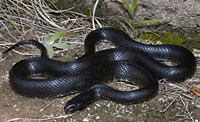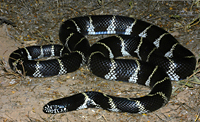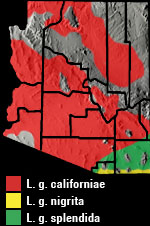Online Field Guide to The Reptiles and Amphibians of Arizona


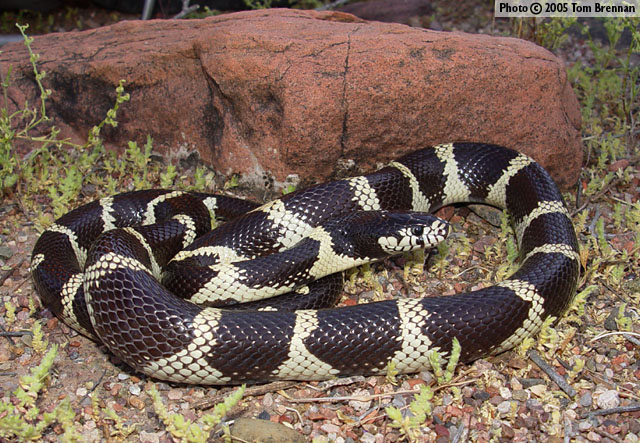
Gila County, AZ
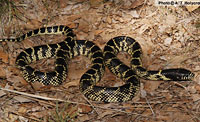 L. g. splendida. Cochise Co., AZ |
||
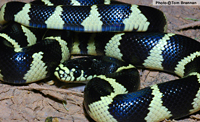 Juvenile. Maricopa Co., AZ |
| COMMON KINGSNAKE Lampropeltis getula |
Non-Venomous
|
| DESCRIPTION: A large (up to 1,422 mm or 56″ in total length) snake with markings that vary depending on the location/subspecies (see subspecies descriptions below). Base coloration is black or very dark brown. Over most of its range in Arizona it has white rings. In southeastern Arizona it is marked with yellow speckles on the sides and thin yellow bands across the back. Solid black specimens are occasionally encountered in extreme southern Arizona along the border with Mexico. The scales are smooth and shiny and the pupils are round.
DISTRIBUTION: This snake is found across most of the state. It is absent from Arizona’s higher mountains and the high elevations of Mogollon Rim country. In Arizona it ranges in elevation from near sea level at Yuma to about 6,000′. HABITAT: In Arizona the Common Kingsnake is found in biotic communities ranging from the desertscrubs, through the grasslands, and into the lower reaches of Madrean Evergreen Woodland and Great Basin Conifer Woodland. It seems to be most abundant in areas near water such as riparian corridors, large drainages, agriculture and orchards, mesquite bosques, and grasslands. It is less commonly encountered in open and dry desert areas.BEHAVIOR: This ground-dweller is primarily diurnal in spring and fall and nocturnal during the hot summer months. It hibernates during the cold months of late fall and winter. When captured or persistently harassed it may roll into a ball with its head hidden within the coils.DIET: This is a powerful constrictor that preys on snakes (including rattlesnakes), mice, rats, lizards, amphibians, reptile eggs, small turtles, and birds.REPRODUCTION: Mating takes place in spring and a clutch of up to 24 eggs is laid in late spring or early summer. Hatchlings begin to emerge in August. SUBSPECIES FOUND IN AZ:CALIFORNIA KINGSNAKE Lampropeltis getula californiae. This subspecies is black or dark brown and has 21 to 45 white bands. The bands become wider on the lower sides. The snout and face are usually marked with small white blotches. WESTERN BLACK KINGSNAKE Lampropeltis getula nigrita. This subspecies is solid black. Some individuals have isolated small white speckles. DESERT KINGSNAKE Lampropeltis getula splendida. This subspecies has yellow speckles and patches on the sides and 45 to 95 thin yellow bands across the back. The snout and face are usually marked with small yellow blotches. REMARKS: Animals that appear to be intergrades occur in subspecies contact zones. By Thomas C. Brennan Bartlett. 2000. Snakes of North America: Western Region. Gulf Publishing Co. Houston, TX Brennan, T. C., and A. T. Holycross. 2006. A Field Guide to Amphibians and Reptiles in Arizona. Arizona Game and Fish Department. Phoenix, AZ Brennan, T. C., and A. T. Holycross. 2005. A Field Guide to Amphibians and Reptiles of Maricopa County. Arizona Game and Fish Department. Phoenix, AZ Degenhardt, W. G., Painter, C. W., and Price, A. H.. 1996. Amphibians and Reptiles of New Mexico. University of New Mexico Press. Albuquerque. Fowlie. 1965. The Snakes of Arizona. Azul Quinta Press, Fallbrook, California Stebbins. 1985. Western Reptiles and Amphibians. Houghton Mifflin. New York, |
|
Visit Partners in Amphibian and Reptile Conservation:


HOME
Copyright © 2023, Arizona Game and Fish Department. All rights reserved.
If you make use of the textual contents of this site in reports, publications, etc. please cite and credit the author(s) and photographer(s). All photos on this website are copyrighted. However, those found in the species account section may be used for any noncommercial scientific, educational, or conservation purposes provided that photographs are not altered and continue to bear the copyright symbol and name of the photographer. Please contact the photographer regarding commercial use of copyrighted photographs.










